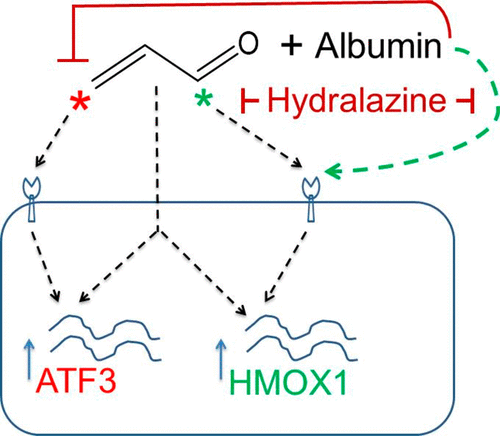当前位置:
X-MOL 学术
›
Chem. Res. Toxicol.
›
论文详情
Our official English website, www.x-mol.net, welcomes your feedback! (Note: you will need to create a separate account there.)
Albumin Protects Lung Cells against Acrolein Cytotoxicity and Acrolein-Adducted Albumin Increases Heme Oxygenase 1 Transcripts.
Chemical Research in Toxicology ( IF 4.1 ) Pub Date : 2020-06-12 , DOI: 10.1021/acs.chemrestox.0c00146 Kiflai Bein 1 , Rahel L Birru 1 , Heather Wells 1 , Theodore P Larkin 1 , Pamela S Cantrell 2 , Matthew V Fagerburg 2, 3 , Xuemei Zeng 2 , George D Leikauf 1
Chemical Research in Toxicology ( IF 4.1 ) Pub Date : 2020-06-12 , DOI: 10.1021/acs.chemrestox.0c00146 Kiflai Bein 1 , Rahel L Birru 1 , Heather Wells 1 , Theodore P Larkin 1 , Pamela S Cantrell 2 , Matthew V Fagerburg 2, 3 , Xuemei Zeng 2 , George D Leikauf 1
Affiliation

|
Albumin is an abundant protein in the lung lining fluid that forms an interface between lung epithelial cells and the external environment. In the lung, albumin can be targeted for adduction by inhaled acrolein. Acrolein, an α,β-unsaturated aldehyde, reacts with biomolecules via Michael addition at the β-carbon or Schiff base formation at the carbonyl carbon. To gain insight into acrolein’s mode of action, we investigated in vitro albumin–acrolein reactivity and the consequence of albumin adduction by acrolein on cytotoxicity and transcript changes in NCI-H441 and human airway epithelial cells (HAEC). Albumin protected NCI-H441 cells from acrolein toxicity. In addition, albumin inhibited acrolein-induced increase of transcripts associated with cellular stress response, activating transcription factor 3 (ATF3), and antioxidant response, heme oxygenase 1 (HMOX1) in HAEC cells. Acrolein-adducted albumin itself increased HMOX1 transcripts but not ATF3 transcripts. The HMOX1 transcript increase was inhibited by hydralazine, a carbonyl scavenger, suggesting that the carbonyl group of acrolein-adducted albumin mediated HMOX1 transcript increase. In acutely exposed C57BL/6J mice, bronchoalveolar lavage protein carbonylation increased. Acrolein-adducted albumin Cys34 was identified by nLC-MS/MS. These findings indicate that adduction of albumin by acrolein confers a cytoprotective function by scavenging free acrolein, decreasing a cellular stress response, and inducing an antioxidant gene response. Further, these results suggest that β-carbon reactivity may be required for acrolein’s cytotoxicity and ATF3 transcript increase, and the carbonyl group of acrolein-adducted albumin can induce HMOX1 transcript increase.
中文翻译:

白蛋白保护肺细胞免受丙烯醛细胞毒性和丙烯醛加合的白蛋白增加血红素加氧酶 1 转录本。
白蛋白是肺内衬液中丰富的蛋白质,在肺上皮细胞和外部环境之间形成界面。在肺中,白蛋白可以通过吸入丙烯醛靶向内收。丙烯醛是一种 α,β-不饱和醛,通过在 β-碳上的迈克尔加成或在羰基碳上形成席夫碱与生物分子反应。为了深入了解丙烯醛的作用方式,我们进行了体外研究白蛋白 - 丙烯醛反应性以及丙烯醛加合白蛋白对 NCI-H441 和人气道上皮细胞 (HAEC) 的细胞毒性和转录物变化的影响。白蛋白保护 NCI-H441 细胞免受丙烯醛毒性。此外,白蛋白抑制丙烯醛诱导的 HAEC 细胞中与细胞应激反应、激活转录因子 3 (ATF3) 和抗氧化反应、血红素加氧酶 1 (HMOX1) 相关的转录物增加。丙烯醛加合物白蛋白本身增加了 HMOX1 转录本,但不增加 ATF3 转录本。HMOX1 转录物的增加受到羰基清除剂肼苯哒嗪的抑制,表明丙烯醛加合白蛋白的羰基介导了 HMOX1 转录物的增加。在急性暴露的 C57BL/6J 小鼠中,支气管肺泡灌洗蛋白羰基化增加。通过 nLC-MS/MS 鉴定丙烯醛加合的白蛋白 Cys34。这些发现表明,丙烯醛对白蛋白的加合通过清除游离丙烯醛、降低细胞应激反应和诱导抗氧化基因反应来赋予细胞保护功能。此外,这些结果表明,丙烯醛的细胞毒性和 ATF3 转录物增加可能需要 β-碳反应性,并且丙烯醛加合物白蛋白的羰基可诱导 HMOX1 转录物增加。
更新日期:2020-07-20
中文翻译:

白蛋白保护肺细胞免受丙烯醛细胞毒性和丙烯醛加合的白蛋白增加血红素加氧酶 1 转录本。
白蛋白是肺内衬液中丰富的蛋白质,在肺上皮细胞和外部环境之间形成界面。在肺中,白蛋白可以通过吸入丙烯醛靶向内收。丙烯醛是一种 α,β-不饱和醛,通过在 β-碳上的迈克尔加成或在羰基碳上形成席夫碱与生物分子反应。为了深入了解丙烯醛的作用方式,我们进行了体外研究白蛋白 - 丙烯醛反应性以及丙烯醛加合白蛋白对 NCI-H441 和人气道上皮细胞 (HAEC) 的细胞毒性和转录物变化的影响。白蛋白保护 NCI-H441 细胞免受丙烯醛毒性。此外,白蛋白抑制丙烯醛诱导的 HAEC 细胞中与细胞应激反应、激活转录因子 3 (ATF3) 和抗氧化反应、血红素加氧酶 1 (HMOX1) 相关的转录物增加。丙烯醛加合物白蛋白本身增加了 HMOX1 转录本,但不增加 ATF3 转录本。HMOX1 转录物的增加受到羰基清除剂肼苯哒嗪的抑制,表明丙烯醛加合白蛋白的羰基介导了 HMOX1 转录物的增加。在急性暴露的 C57BL/6J 小鼠中,支气管肺泡灌洗蛋白羰基化增加。通过 nLC-MS/MS 鉴定丙烯醛加合的白蛋白 Cys34。这些发现表明,丙烯醛对白蛋白的加合通过清除游离丙烯醛、降低细胞应激反应和诱导抗氧化基因反应来赋予细胞保护功能。此外,这些结果表明,丙烯醛的细胞毒性和 ATF3 转录物增加可能需要 β-碳反应性,并且丙烯醛加合物白蛋白的羰基可诱导 HMOX1 转录物增加。



























 京公网安备 11010802027423号
京公网安备 11010802027423号